Physical Security Statistics By Market, Revenue And Facts (2025)
Updated · Sep 10, 2025

Table of Contents
- Introduction
- Editor’s Choice
- Physical Security Market Statistics
- Physical Security Revenue Statistics By Component
- Physical Security Solutions Statistics
- Business Impacts of Physical Security
- Strategies for Improving Physical Security
- Top Physical Security Initiative Statistics
- Top Investments for Physical Security Operations Integration
- Workplace Security Statistics
- Physical Security Statistics by Future Updates
- Conclusion
Introduction
Physical Security Statistics: Physical security plays an important role in enabling protection to people, property, and assets from threats such as theft, vandalism, espionage, and terrorism. By combining technology, personnel, and protocols, organisations aim to prevent unauthorised access and minimise risks.
This security also prevents different unauthorised access to facilities, equipment, and resources. It uses multiple-layered systems such as CCTV, security guards, locks, access control, barriers, intrusion detection, fire protection, and other deterrents to ensure safety and security.
This article on physical security statistics highlights current trends, challenges, and the effectiveness of various protective measures worldwide.
Editor’s Choice
- According to a report published by market.us in 2024, the global physical security market accounted for around USD 152.8 billion and will reach USD 168.0 billion by 2025.
- Based on components, in 2025, revenue from systems is expected to reach USD 100.8 billion, while services are projected to earn USD 67.2 billion.
- According to Grand View Research, the large enterprises segment recorded USD 91,555.0 million in 2024 and is forecasted to hit USD 123,542.9 million by 2030, advancing at a 5% CAGR between 2025 and 2030.
- In 2024, the North American physical security market generated USD 56,581.8 million in revenue.
- The United States’ physical security market generated a revenue of USD 56,581.8 million.
- Access Control is used as the best physical security solution that secured the highest market share at 50%.
- Almost 44% of physical security incidents do not cause any noticeable effect on business.
- The Infotech.com report shows 50% of investments go to access control systems, helping stop unauthorized entry and quickly detect risks.
Physical Security Market Statistics
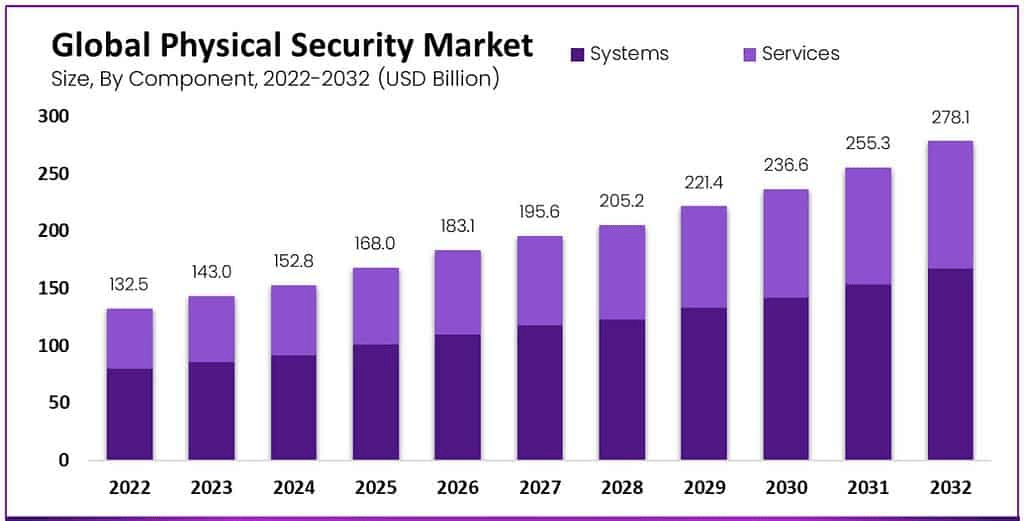
- As of 2024, the global physical security market size was valued at USD 152.8 billion and will reach USD 168.0 billion by 2025.
- The market is expected to grow enormously in the coming years, resulting in USD 183.1 billion by 2026, USD 195.6 billion by 2027, USD 205.2 billion by 2028, and USD 221.4 billion by 2029.
- Looking further ahead, the market is projected to surpass USD 236.6 billion in 2030, USD 255.3 billion in 2031, and USD 278.1 billion in 2032.
- The growth rate of the market will grow at a 7.9% CAGR between 2024 and 2032.
Physical Security Revenue Statistics By Component
- In 2024, the physical security market generated USD 91.7 billion from systems and USD 61.1 billion from services.
- The following year, 2025, revenue from systems is expected to reach USD 100.8 billion, while services are projected to earn USD 67.2 billion.
Furthermore, in the coming years, the estimated market revenue in different components is stated below:
| Year | System | Services |
| (USD billion) | ||
| 2026 | 109.8 |
73.2 |
|
2027 |
117.4 | 78.3 |
| 2028 | 123.1 |
82.1 |
|
2029 |
132.8 | 88.5 |
| 2030 | 142 |
94.6 |
|
2031 |
153.2 | 102.1 |
| 2032 | 166.9 |
111.2 |
Moreover, other components market segmentations are mentioned below:
| Components | Market Size (USD million) | CAGR (2025 to 2030) |
|
| 2024 | 2030 | ||
| Video Surveillance System | 47,169.5 | 63,396.6 | 4.9% |
| Physical Identity & Access Management (PIAM) | 5,740.9 | 9,640.2 | 8.9% |
| Physical Access Control Systems (PACS) | 15,491.7 | 21,447 | 5.4% |
| Physical Security Information Management (PSIM) | 4,864.2 | 9,218.4 | 11% |
| Perimeter Intrusion Detection And Prevention | 14,004.2 | 21,473.1 | 7.2% |
| Fire And Life Safety | 8,620.6 | 13,802.8 | 8% |
| Remote Monitoring | 16,673.4 | 23,998.6 | 6.1% |
| System Integration | 25,243 | 38,496.4 | 7.2% |
By Organization Size
- According to Grand View Research, the large enterprises segment recorded USD 91,555.0 million in 2024 and is forecasted to hit USD 123,542.9 million by 2030, advancing at a 5% CAGR between 2025 and 2030.
- Meanwhile, the small and medium enterprises (SMEs) generated USD 58,455.9 million in 2024, with projections showing growth to USD 97,172.2 million by 2030, supported by a stronger 8.7% CAGR during the same timeframe.
By Application
| Metrics | Market Size (USD million) | CAGR(2025 to 2030) | |
| 2024 | 2030 | ||
| Residential | 21,096.8 | 32,320.5 | 7.5% |
| Hospitality | 10,086.2 | 13,894.2 | 5.3% |
| Government | 26,737.7 | 39,588.7 | 6.6% |
| Utility and Energy | 11,918.1 | 17,703.8 | 6.7% |
| Retail | 10,007.6 | 14,621.4 | 6.4% |
| Commercial | 20,221.7 | 30,575.8 | 7% |
| Industrial | 9,190.7 | 12,854.2 | 5.6% |
| Transportation | 17,084.9 | 26,236.1 | 7.3% |
| Banking and Finance | 14,925.1 | 21,350.7 | 6% |
By Region
- In 2024, the North American physical security market generated USD 56,581.8 million in revenue, according to grandviewresearch.com.
- In contrast, the sector is projected to reach USD 80,642.6 million by 2030.
- Meanwhile, the market is expected to advance at a 6% CAGR between 2025 and 2030.
Furthermore, other regions’ analyses are stated in the table below:
| Regions | Market Size (USD million) | CAGR (2025 to 2030) | |
| 2024 | 2030 | ||
|
Europe |
29,991.6 | 38,360 | 4% |
| Asia Pacific | 49,189.4 | 80,365 | 8.3% |
|
Latin America |
3,153.4 | 4,751.3 | 6.9% |
| Middle East & Africa | 8,445.6 | 12,310.7 | 6.4% |
By Country
- The United States’ physical security market generated a revenue of USD 56,581.8 million in 2024.
- By the end of 2030, it is projected to reach USD 80,642.6 million, expanding at a compound annual growth rate (CAGR) of 6% from 2025 to 2030.
| Regions | Market Size (USD million) | CAGR (2025 to 2030) | |
| 2024 | 2030 | ||
| Canada | 14,973.9 | 22,563.9 | 6.9% |
| Mexico | 757.2 | 1,273.1 | 8.9% |
| United Kingdom | 9,933.4 | 12,929.9 | 4.3% |
| Germany | 9,116.3 | 12,361.3 | 5% |
| France | 6,467.2 | 8,075.8 | 3.6% |
| China | 22,701.8 | 40,124.6 | 9.8% |
| India | 7,832.4 | 14,408.3 | 10.5% |
| Japan | 12,033.9 | 18,599.5 | 7.3% |
| Brazil | 1,381 | 2,095 | 7.1% |
Physical Security Solutions Statistics
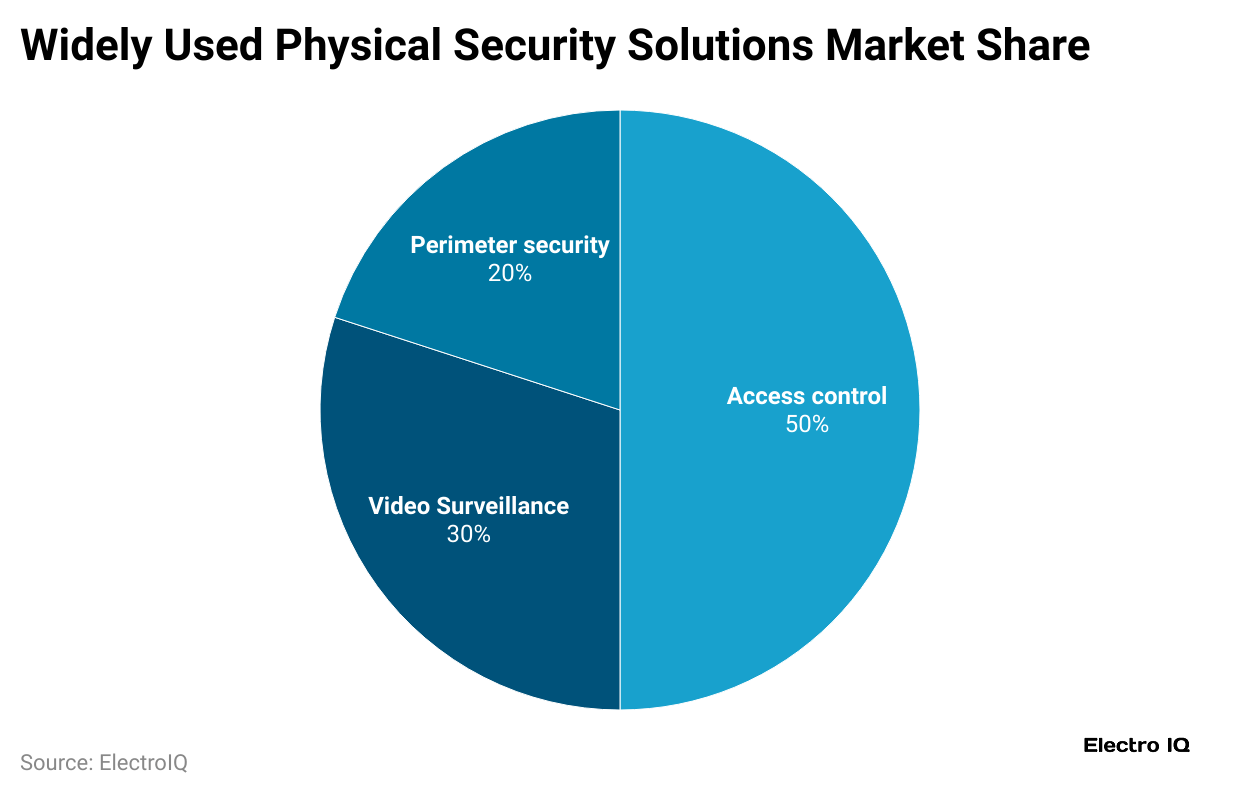
- Access Control is used as the best physical security solution option that secured the highest market share at 50%.
- Moreover, the second usage share of Physical Security was made up by video surveillance with 30%, followed by perimeter security (20%).
Business Impacts of Physical Security
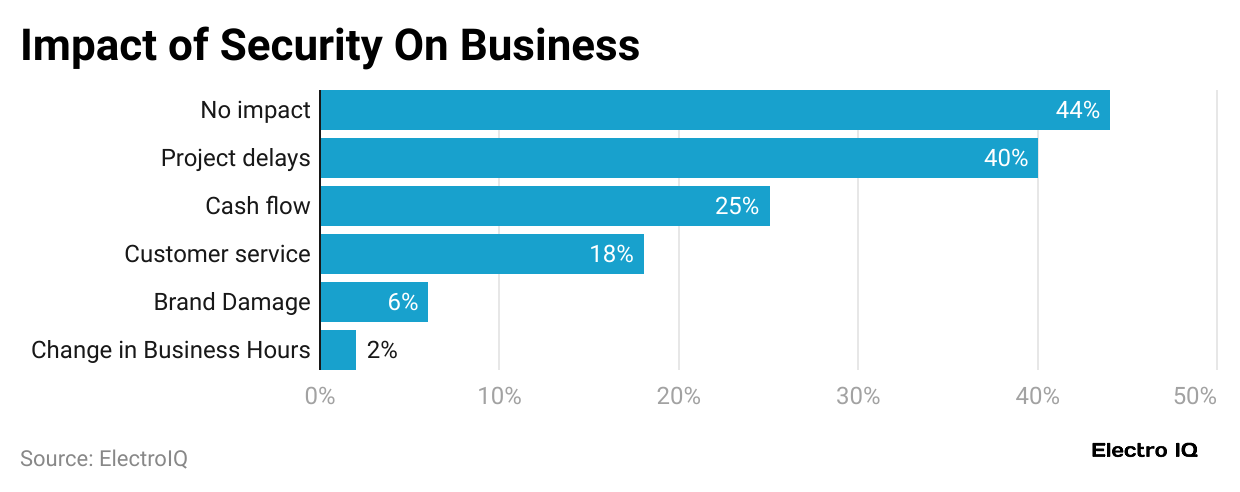
- Almost 44% of physical security incidents do not cause any noticeable effect on business.
- The next two security incidents on businesses are project delays by 40% and cash flow by 25%
- Furthermore, other factors impacting the businesses include customer service (18%), brand damage (6%), and a change in business hours (2%).
Strategies for Improving Physical Security
| Metrics | Business share | Specifications |
| Installed security video cameras | 47% | Used advanced surveillance technology to monitor and protect premises. |
| Strategy hasn’t changed | 42% | Businesses kept their existing security measures unchanged. |
| Installed fencing | 22% | Strengthened perimeters to deter potential threats. |
| Installed alarm system | 14% | Enabled real-time surveillance from remote locations. |
| Deployed remote monitoring (RVM) | 14% | Installed a system to provide instant alerts for security breaches. |
| Access security guards | 7% | Regulated and restricted entry to specific areas. |
| Deployed access control | 7% | Increased security personnel |
Top Physical Security Initiative Statistics
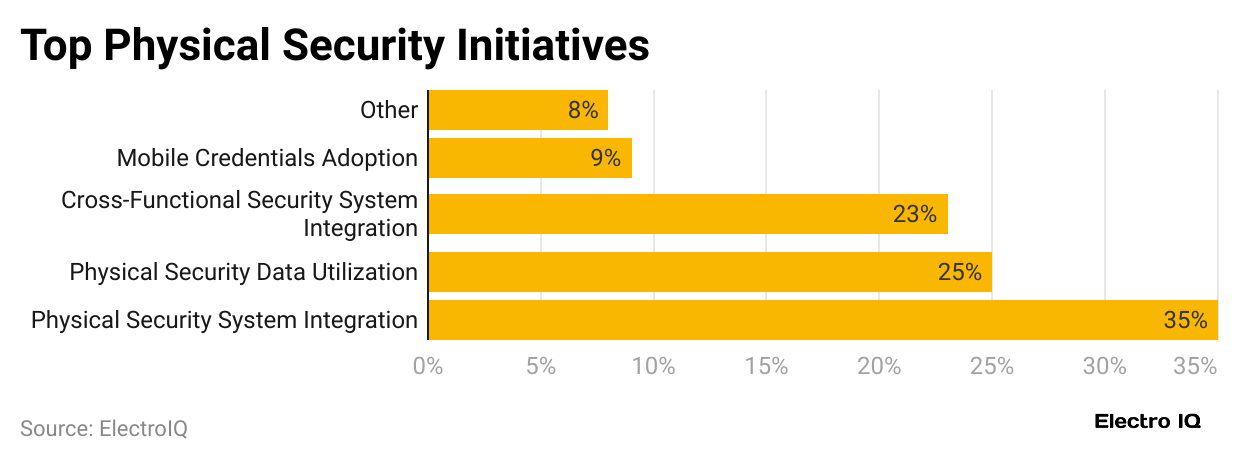
- The largest focus is on physical security systems integration, which accounts for 35%.
- Physical security data utilization follows at 25%, reflecting the growing importance of using data for smarter decision-making in security management.
- Cross-functional security systems integration comes next at 23%.
- Meanwhile, mobile credentials adoption represents 9%, indicating a shift toward mobile-based access solutions.
- Lastly, 8% of respondents selected other initiatives outside the main categories.
Top Investments for Physical Security Operations Integration
- The Infotech.com report shows 50% of investments go to access control systems, helping stop unauthorised entry and quickly detect risks.
- Next in line are digital physical security operations combined with cybersecurity at 48%.
- Visitor management systems with threat detection software come at 43%, ensuring safer handling of guests.
- Digital security operations with HR account for 41%, pointing to stronger staff collaboration.
- Finally, cyber-physical security operation centres make up 37%, improving central monitoring.
Workplace Security Statistics
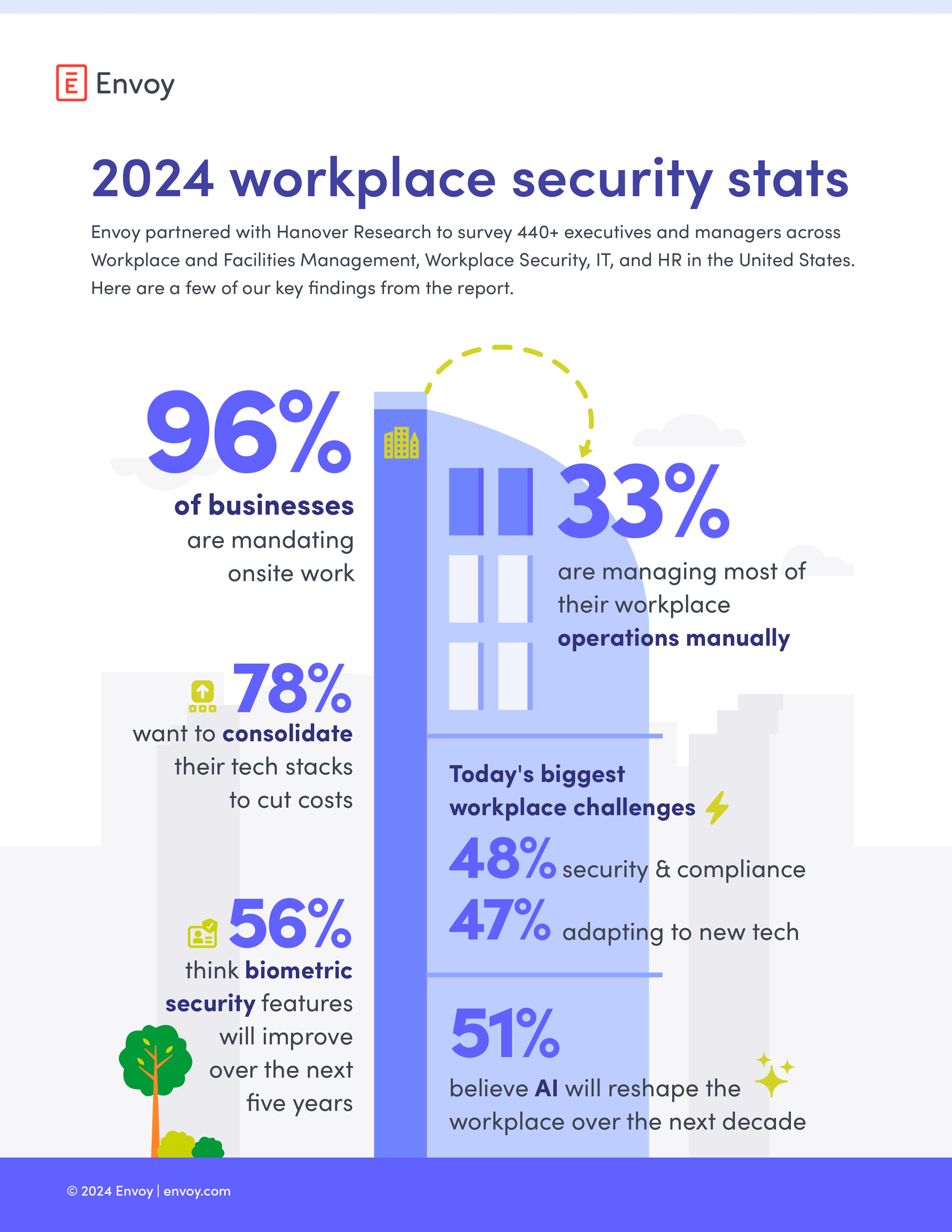
- In 2024, a U.S. Envy.com survey of 440+ executives found 96% of businesses require on-site work, while 33% still handle most workplace operations manually.
- 78% of companies plan to consolidate their technology stacks to lower costs.
- 56% believe adding biometric security features will improve workplace safety within five years.
- 48% of organisations cite security and compliance as top challenges, while 47% struggle with adapting to new technology.
- 51% of respondents expect artificial intelligence (AI) to transform workplace operations significantly in the next decade.
Physical Security Statistics by Future Updates

- In the next 5 years, 66% of global businesses believe that physical security will be transformed into advanced surveillance technologies.
- Meanwhile, 56% claimed better and enhanced biometrics with enhanced security, and 53% wanted total access control innovations.
Conclusion
After completing the topic, it can be concluded that physical security plays an effective role in protecting several important assets from unauthorised access. After enabling this system, many global organisations were able to reduce several risk factors and manage threats more effectively.
Physical security depends on modern technology and several layers of protection to keep people, property, and important assets safe from theft. Tools such as CCTV cameras, access controls, barriers, and fire safety systems help maintain security, reduce losses, and improve the overall safety, efficiency, and strength of facilities and their operations.
Sources
FAQ.
There are two main types: perimeter security and interior security.
Investing in security personnel, conducting frequent audits, using monitoring systems, limiting facility access, educating your employees, and implementing sensors.
The five D’s are deter, detect, deny, delay, and defend.
Physical security is built around three key layers: outer perimeter, inner perimeter, and the building’s interior.
Maximum security is known to be the toughest level, aiming to detect, prevent, and respond to all threats.

Maitrayee Dey has a background in Electrical Engineering and has worked in various technical roles before transitioning to writing. Specializing in technology and Artificial Intelligence, she has served as an Academic Research Analyst and Freelance Writer, particularly focusing on education and healthcare in Australia. Maitrayee's lifelong passions for writing and painting led her to pursue a full-time writing career. She is also the creator of a cooking YouTube channel, where she shares her culinary adventures. At Smartphone Thoughts, Maitrayee brings her expertise in technology to provide in-depth smartphone reviews and app-related statistics, making complex topics easy to understand for all readers.










